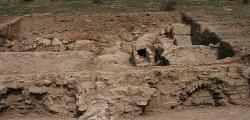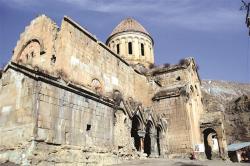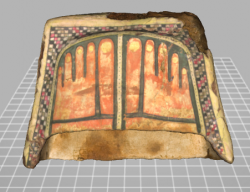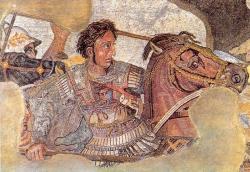INSTITUT SUPERIEUR D'ANTHROPOLOGIE
INSTITUTE OF ANTHROPOLOGY
ONLINE COURSES / COURS A DISTANCE
SUMMER TERM : JULY 2014
REGISTER NOW
BULGARIE –  Heraclea Sintica - A team of Bulgarian and American archaeologists will explore the foundations of the ancient city Heraclea Sintica near the temple of the prophetess Vanga. American students of archaeology will arrive in Bulgaria to help with the excavations at the beginning of June. "Our work is funded primarily by the American Research Institute. Without their help we could not have made it this far," admitted Sotir Ivanov, curator of the Historical Museum in Petrich, Southwest Bulgaria. The Americans will spend a week examining some of the Bulgarian landmarks. During this time the Bulgarian archaeologists will prepare the ground for work. Until 2012 excavations continued throughout July and August, but last year they worked only in June because of the extreme heat. The ancient city is located just 1 km from the Church of Vanga at the foot of Kozhuh, an extinct volcano. Experts have found hundreds of valuable objects in the past few years, some of which are currently exhibited in the museum in Petrich. Part of the site has been restored and remnants of urban infrastructure have been discovered. Experts have also come upon early Christian graves. Cramic objects, stones from a catapult, columns, theater masks and terracotta figures are among the other findings. "We also came across a votive tablet depicting the goddess of retribution Nemesis and weapons such as arrows and lead weights for slingshots. I speak of objects dating from the 4th century BC to the 5th century AD. The museum preserves a coin with the image of the Roman Emperor Flavius Marcianus", revealed Sotir Ivanov. The archaeologists hope to find the remnants of a theater, a forum and some public buildings this year.Копирано от standartnews.com
Heraclea Sintica - A team of Bulgarian and American archaeologists will explore the foundations of the ancient city Heraclea Sintica near the temple of the prophetess Vanga. American students of archaeology will arrive in Bulgaria to help with the excavations at the beginning of June. "Our work is funded primarily by the American Research Institute. Without their help we could not have made it this far," admitted Sotir Ivanov, curator of the Historical Museum in Petrich, Southwest Bulgaria. The Americans will spend a week examining some of the Bulgarian landmarks. During this time the Bulgarian archaeologists will prepare the ground for work. Until 2012 excavations continued throughout July and August, but last year they worked only in June because of the extreme heat. The ancient city is located just 1 km from the Church of Vanga at the foot of Kozhuh, an extinct volcano. Experts have found hundreds of valuable objects in the past few years, some of which are currently exhibited in the museum in Petrich. Part of the site has been restored and remnants of urban infrastructure have been discovered. Experts have also come upon early Christian graves. Cramic objects, stones from a catapult, columns, theater masks and terracotta figures are among the other findings. "We also came across a votive tablet depicting the goddess of retribution Nemesis and weapons such as arrows and lead weights for slingshots. I speak of objects dating from the 4th century BC to the 5th century AD. The museum preserves a coin with the image of the Roman Emperor Flavius Marcianus", revealed Sotir Ivanov. The archaeologists hope to find the remnants of a theater, a forum and some public buildings this year.Копирано от standartnews.com
http://www.standartnews.com/english/read/american_archaeologists_explore_spectacular_ancient_city_in_bulgaria_-3502.html
TURQUIE –  - Turkey’s Culture and Tourism Ministry has announced the list of historical artifacts held in foreign countries that it requested the return of last year. The artifacts, whose return process continues through diplomatic relations and bilateral discussions, are listed in the report as follows: Germany: Hacı İbrahim Veli sarcophagus, the statue of the Old Fisherman, a section from the Konya Beyhekim Mosque, the tile pediment of Piyale Paşa Mosque and a window sash of Beyhekim Mosque and a silver frescoed belt in the Pergamum Museum, which was seized through Dusseldorf Airport. U.S.: Zeugma mosaics at the Bowling Green University Wolfe Arts Center, Kumluca artifacts at Dumbarton Oaks Museum, and pieces from the ancient sites of Bubon, Kremna and the Alahıdır Tumlus at the J. Paul Getty Museum. Britain: The Head of Eros at the Victoria & Albert Museum. France: The original İznik tiles from the tombs of Selim II and Murat III, and the Mahmud I Library at the Louvre Museum. Denmark: Bronze sphinxes, the door handle of the Cizre Ulu Mosque, Quran pages of the Nuruosmaniye Mosque Library, the sarcophagus of the Akşehir Seyyid Mahmud Hayrani Tomb, the chandelier of the Hacı Bayram Veli Tomb and a carpet and mosque chandelier of the Beyşehir Eşrefoğlu Mosque.
- Turkey’s Culture and Tourism Ministry has announced the list of historical artifacts held in foreign countries that it requested the return of last year. The artifacts, whose return process continues through diplomatic relations and bilateral discussions, are listed in the report as follows: Germany: Hacı İbrahim Veli sarcophagus, the statue of the Old Fisherman, a section from the Konya Beyhekim Mosque, the tile pediment of Piyale Paşa Mosque and a window sash of Beyhekim Mosque and a silver frescoed belt in the Pergamum Museum, which was seized through Dusseldorf Airport. U.S.: Zeugma mosaics at the Bowling Green University Wolfe Arts Center, Kumluca artifacts at Dumbarton Oaks Museum, and pieces from the ancient sites of Bubon, Kremna and the Alahıdır Tumlus at the J. Paul Getty Museum. Britain: The Head of Eros at the Victoria & Albert Museum. France: The original İznik tiles from the tombs of Selim II and Murat III, and the Mahmud I Library at the Louvre Museum. Denmark: Bronze sphinxes, the door handle of the Cizre Ulu Mosque, Quran pages of the Nuruosmaniye Mosque Library, the sarcophagus of the Akşehir Seyyid Mahmud Hayrani Tomb, the chandelier of the Hacı Bayram Veli Tomb and a carpet and mosque chandelier of the Beyşehir Eşrefoğlu Mosque.
http://www.hurriyetdailynews.com/turkey-continues-hunt-for-historic-artifacts-abroad-.aspx?pageID=238&nID=65839&NewsCatID=375
QATAR - Under the patronage of HE Sheikh Hassan bin Mohamed al-Thani, vice-chairman of the Qatar Museums Authority and president of the Qatar-Sudan Archaeological Project joint committee, QSAP yesterday celebrated the launch of its website at the QMA headquarters. Members of the Sudanese community in Qatar and the media were briefed on the new website that covers the activities of about 40 archaeological missions working in the Northern State and Nile State of Sudan. Covering various aspects of archaeological research work in Sudan and Sudanese heritage, the website includes sections highlighting the museums of Sudan, archaeological sites and the history of the country in both English and Arabic. It targets the general public as well as students conducting research on Sudanese archaeology and heritage. The website has been designed by the QMA I-T Department and the QSAP team. It can be accessed at www.qsap.qa or www.qsap.org.
http://www.gulf-times.com/qatar/178/details/390542/archaeological-project-launches-new-website
TURQUIE –  Uzundere - The Öşvank Monastery in the eastern province of Erzurum’s Uzundere district will be restored with stones to be brought from a historic stone pit. The church was built by Georgian King Curopalate Adernese’s sons between 963 and 973. One of the most significant historical structures in eastern Anatolia, the Öşvank Monastery is in the village of Çamlıyamaç. It was constructed between 963-973 A.D. and was dedicated to St. John the Baptist and donated by the Bagratid brothers, sons of the Georgian Curopalate Adernese, King David and Prince Bagrat. During the time when the region was under the reign of the Byzantine Emperors, the dome of the church was repaired by the Emperors Basil II and Constantine VIII. In the 11th century, the monastery was one of the most important bishoprics in the region and a center of culture, especially famous for its manuscripts. It preserved its importance until the end of the 15th century. At the end of the 19th century, the church was converted into a mosque and functioned as a place of worship until 1980.
Uzundere - The Öşvank Monastery in the eastern province of Erzurum’s Uzundere district will be restored with stones to be brought from a historic stone pit. The church was built by Georgian King Curopalate Adernese’s sons between 963 and 973. One of the most significant historical structures in eastern Anatolia, the Öşvank Monastery is in the village of Çamlıyamaç. It was constructed between 963-973 A.D. and was dedicated to St. John the Baptist and donated by the Bagratid brothers, sons of the Georgian Curopalate Adernese, King David and Prince Bagrat. During the time when the region was under the reign of the Byzantine Emperors, the dome of the church was repaired by the Emperors Basil II and Constantine VIII. In the 11th century, the monastery was one of the most important bishoprics in the region and a center of culture, especially famous for its manuscripts. It preserved its importance until the end of the 15th century. At the end of the 19th century, the church was converted into a mosque and functioned as a place of worship until 1980.
http://www.hurriyetdailynews.com/georgian-monastery-in-eruzum-to-regain-its-glory.aspx?pageID=238&nid=65785&NewsCatID=375
EGYPTE –  CL’s Petrie Museum of Egyptian Archaeology, which holds one of the top specialist collections of ancient Egyptian artefacts in the world, has launched an interactive online 3D object library.
CL’s Petrie Museum of Egyptian Archaeology, which holds one of the top specialist collections of ancient Egyptian artefacts in the world, has launched an interactive online 3D object library.
http://www.ucl.ac.uk/3dpetriemuseum
EGYPTE –  Kom el-Dikka - A team of archaeologists and historians from the Polish Center of Archaeology have revealed a mausoleum made of marble and gold that might be the tomb of Alexander the Great. The site is situated in an area known as Kom el-Dikka in the heart of downtown Alexandria, only 60 meters away from the Mosque of Nebi Daniel. The monument was apparently sealed off and hidden in the 3rd or 4th century AD, to protect it from the Christian repression and destruction of pagan monuments after the change of the official religion within the Roman Empire. It is a testimony to the multicultural nature of Alexander’s empire, as it combines artistic and architectural influences from Greek, Egyptian, and Persian cultures. The inscriptions are mainly in Greek but there are also a few Egyptian hieroglyphs, mentioning that the mausoleum is dedicated to the “King of Kings, and Conqueror of the World, Alexander III.” The finding is extremely important as it can provide new information about Alexander the Great. The mausoleum contains a broken sarcophagus made of crystal glass, 37 bones, mostly heavily damaged but presumably all from the same adult male, as well as some broken pottery dating from the Ptolemaic and Roman ages. A carbon-dating analysis and a series of other tests will determine the age of the bones and whether or not they belong to the Macedonian King.
Kom el-Dikka - A team of archaeologists and historians from the Polish Center of Archaeology have revealed a mausoleum made of marble and gold that might be the tomb of Alexander the Great. The site is situated in an area known as Kom el-Dikka in the heart of downtown Alexandria, only 60 meters away from the Mosque of Nebi Daniel. The monument was apparently sealed off and hidden in the 3rd or 4th century AD, to protect it from the Christian repression and destruction of pagan monuments after the change of the official religion within the Roman Empire. It is a testimony to the multicultural nature of Alexander’s empire, as it combines artistic and architectural influences from Greek, Egyptian, and Persian cultures. The inscriptions are mainly in Greek but there are also a few Egyptian hieroglyphs, mentioning that the mausoleum is dedicated to the “King of Kings, and Conqueror of the World, Alexander III.” The finding is extremely important as it can provide new information about Alexander the Great. The mausoleum contains a broken sarcophagus made of crystal glass, 37 bones, mostly heavily damaged but presumably all from the same adult male, as well as some broken pottery dating from the Ptolemaic and Roman ages. A carbon-dating analysis and a series of other tests will determine the age of the bones and whether or not they belong to the Macedonian King.
http://world.greekreporter.com/2014/04/30/egypt-archaeologist-may-have-discovered-tomb-of-alexander-the-great/